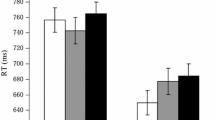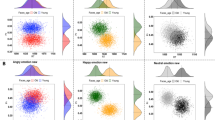Abstract
Though age-related difference in most cognitive performance has been found, there was no previous research examining age difference in multiple social categorizations. Using faces as stimuli and Garner Selective Attention Paradigm, this study explored the different characteristics of implicit and explicit social categorization between young and older adults. The results showed that young perceivers explicitly categorized gender and age of the faces faster and more readily than older perceivers did. When young adults judged specific category (gender category in Experiment 1; age category in Experiment 2), they were interfered from the completing irrelative category; however, irrelative category could not capture older adults’ attention. These results first suggest perceivers’ age indeed plays an important role in multiple social categorizations.





Similar content being viewed by others
References
Abbenhuis MA, Raaijmakers WG, Raaijmakers JG, van Woerden GJ (1990) Episodic memory in dementia of the alzheimer type and in normal ageing: similar impairment in automatic processing. Q J Exp Psychol 42(3):569–583
Allport GW (1954) The nature of prejudice. Addison-Wesley, Reading
Bai L, Ma H, Huang YX, Luo YJ (2005) The development of native Chinese affective picture system—a pretest in 46 college students. Chin Ment Health J 19(11):719–722
Bernard JA, Seidler RD (2014) Moving forward: age effects on the cerebellum underlie cognitive and motor declines. Neurosci Biobehav Rev 42:193–207
Bischoff-Ferrari HA, Willett WC, Wong JB, Stuck AE, Staehelin HB, Orav EJ, Henschkowski J (2009) Prevention of nonvertebral fractures with oral vitamin D and dose dependency: a meta-analysis of randomized controlled trials. Arch Intern Med 169(6):551–561
Blair IV (2002) The malleability of automatic stereotypes and prejudice. Personal Soc Psychol Rev 6(3):242–261
Bopp KL, Verhaeghen P (2005) Aging and verbal memory span: a meta-analysis. J Gerontol 60(5):223–233
Campbell KL, Hasher L, Thomas RC (2010) Hyper-binding: a unique age effect. Psychol Sci 21(3):399–405
Craik FIM, Salthouse TA (2008) The handbook of aging and cognition. Psychology Press, New York
Cullum S, Huppert FA, McGee M, Dening T, Ahmed A, Paykel ES, Brayne C (2000) Decline across different domains of cognitive function in normal ageing: results of a longitudinal population-based study using camcog. Int J Geriatr Psychiatry 15(9):853–862
Daniel S, Bentin S (2012) Age-related changes in processing faces from detection to identification: ERP evidence. Neurobiol Aging 33(1):201–206
Devine PG (1989) Stereotypes and prejudice: their automatic and controlled components. J Pers Soc Psychol 56(1):5–18
Duncan LA, Park JH, Faulkner J, Schaller M, Neuberg SL, Kenrick DT (2007) Adaptive allocation of attention: effects of sex and sociosexuality on visual attention to attractive opposite-sex faces. Evol Hum Behav 28(5):359–364
Eckert MA, Keren NI, Roberts DR, Calhoun VD, Harris KC (2010) Age-related changes in processing speed: unique contributions of cerebellar and prefrontal cortex. Front Hum Neurosci 4(10):1–14
Finkel D, Reynolds CA, McArdle JJ, Pedersen NL (2007) Age changes in processing speed as a leading indicator of cognitive aging. Psychol Aging 22(3):558–568
Fleischman DA (2007) Repetition priming in aging and Alzheimer’s disease: an integrative review and future directions. Cortex 43(7):889–897
Foos PW, Clark MC (2011) Adult age and gender differences in perceptions of facial attractiveness: beauty is in the eye of the older beholder. J Genet Psychol 172(2):162–175
Freeman JB, Ambady N (2011) When two become one: temporally dynamic integration of the face and voice. J Exp Soc Psychol 47(1):259–263
Friedman NP, Miyake A (2004) The relations among inhibition and interference control functions: a latent-variable analysis. J Exp Psychol Gen 133:101–135
Gabrieli JDE (1998) Cognitive neuroscience of human memory. Annu Rev Psychol 49:87–115
Gard T, Hölzel BK, Lazar SW (2014) The potential effects of meditation on age-related cognitive decline: a systematic review. Ann N Y Acad Sci 1307(1):89–103
Garner WR (1974) The processing of information and structure. Erlbaum, Potomac
Gottlob LR, Fillmore MT, Abroms BD (2007) Age-group differences in inhibiting an oculomotor response. Aging Neuropsychol Cogn 14(6):586–593
Grady CL, Craik FI (2000) Changes in memory processing with age. Curr Opin Neurobiol 10(2):224–231
Howard JH, Howard DV, Dennis NA, Yankovich H, Vaidya CJ (2004) Implicit spatial contextual learning in healthy aging. Neuropsychology 18:124–134
Hultsch DF, Masson MEJ, Small BJ (1991) Adult age differences in direct and indirect tests of memory. J Gerontol Psychol Sci 46:22–30
Ito TA, Urland GR (2003) Race and gender on the brain: electrocortical measures of attention to the race and gender of multiply categorizable individuals. J Pers Soc Psychol 85(4):616–626
Ito TA, Urland GR (2005) The influence of processing objectives on the perception of faces: an ERP study of race and gender perception. Cogn Affect Behav Neurosci 5(1):21–36
Karnadewi F, Lipp OV (2011) The processing of invariant and variant face cues in the Garner Paradigm. Emotion 11(3):563–571
Kunda Z, Spencer SJ (2003) When do stereotypes come to mind and when do they color judgment? A goal-based theoretical framework for stereotype activation and application. Psychol Bull 129:522–544
Lepore L, Brown R (1997) Category and stereotype activation: Is prejudice inevitable? J Pers Soc Psychol 72(2):275–287
Light LL, La Voie D, Kennison R (1995) Repetition priming of nonwords in young and older adults. J Exp Psychol Learn Mem Cogn 21(2):327–346
Macrae CN, Bodenhausen GV (2000) Social cognition: thinking categorically about others. Annu Rev Psychol 51:93–120
Maner JK, Miller SL, Moss JH, Leo JL, Plant EA (2012) Motivated social categorization: fundamental motives enhance people’s sensitivity to basic social categories. J Pers Soc Psychol 103(1):70–83
Mitchell DB, Bruss PJ (2003) Age differences in implicit memory: conceptual, perceptual, or methodological? Psychol Aging 18(4):807–822
Park DC, Shaw RJ (1992) Effect of environmental support on implicit and explicit memory in younger and older adults. Psychol Aging 7:632–642
Pettigrew C, Martin RC (2014) Cognitive declines in healthy aging: evidence from multiple aspects of interference resolution. Psychol Aging 29(2):187–204
Purdie-Vaughns V, Eibach RP (2008) Intersectional invisibility: the distinctive advantages and disadvantages of multiple subordinate-group identities. Sex Roles 59(5–6):377–391
Quinn KA, Macrae CN (2005) Categorizing others: the dynamics of person construal. J Pers Soc Psychol 88(3):467–479
Rhodes MG, Anastasi JS (2012) The own-age bias in face recognition: a meta-analytic and theoretical review. Psychol Bull 138(1):146–174
Salthouse TA (1996) The processing-speed theory of adult age differences in cognition. Psychol Rev 103:403–428
Salthouse TA (2004) Localizing age-related individual differences in a hierarchical structure. Intelligence 32(6):541–561
Salthouse TA (2009) Decomposing age correlations on neuropsychological and cognitive variables. J Int Neuropsychol Soc 15(5):650–661
Schuch S, Werheid K, Koch I (2012) Flexible and inflexible task sets: asymmetric interference when switching between emotional expression, sex, and age classification of perceived faces. Q J Exp Psychol 65(5):994–1005
Sesko AK, Biernat M (2010) Prototypes of race and gender: the invisibility of Black women. J Exp Soc Psychol 46(2):356–360
Smyth AC, Shanks DR (2011) Aging and implicit learning: explorations in contextual cuing. Psychol Aging 26(1):127–132
Soldan A, Hilton JH, Cooper LA, Stern Y (2009) Priming of familiar and unfamiliar visual objects over delays in young and older adults. Psychol Aging 24:93–104
Spaan PJ, Raaijmakers JW (2011) Priming effects from young-old to very old age on a word-stem completion task: minimizing explicit contamination. Aging Neuropsychol Cogn 18(1):86–107
Squire LR (2009) Memory and brain systems: 1969–2009. J Neurosci 29(41):12711–12716
Sullivan MP, Faust ME, Balota DA (1995) Identity negative priming in older adults and individuals with dementia of the Alzheimer type. Neuropsychology 9(4):537–555
Tajfel H (1974) Socia identity and intergroup behavior. Soc Sci Inf 14:65–93
Voelkle MC, Ebner NC, Lindenberger U, Riediger M (2012) Let me guess how old you are: effects of age, gender, and facial expression on perceptions of age. Psychol Aging 27(2):265–277
Ward EV, Berry CJ, Shanks DR (2013) An effect of age on implicit memory that is not due to explicit contamination: implications for single and multiple-systems theories. Psychol Aging 28(2):429–442
Wiese H, Schweinberger SR, Neumann MF (2008) Perceiving age and gender in unfamiliar faces: brain potential evidence for implicit and explicit person categorization. Psychophysiology 45(6):957–969
Wittenbrink B, Judd CM (1997) Evidence for racial prejudice at the implicit level and its relationship with questionnaire measures. J Pers Soc Psychol 72:262–274
Zhao M, Hayward WG (2013) Integrative processing of invariant aspects of faces: effect of gender and race processing on identity analysis. J Vis 13(1):1–8
Author information
Authors and Affiliations
Corresponding author
Additional information
Handling editor: Maria Casagrande (Sapienza University of Rome).
Reviewers: Diana Martella (Autonomous University of Chile), Maria Casagrande (Sapienza University of Rome).
Rights and permissions
About this article
Cite this article
Wang, P., Zhang, Q. & Zhang, KL. Older adults show less interference from task-irrelevant social categories: evidence from the garner paradigm. Cogn Process 19, 411–418 (2018). https://doi.org/10.1007/s10339-017-0843-4
Received:
Accepted:
Published:
Issue Date:
DOI: https://doi.org/10.1007/s10339-017-0843-4




